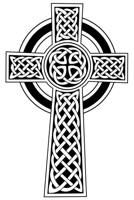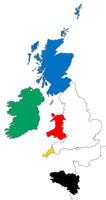
|
The Society of Folk Dance Historians (SFDH) Celts
[
Home |
About |
Encyclopedia | CLICK AN IMAGE TO ENLARGE |

|
The modern Celts are a related group of ethnicities who share similar Celtic languages, cultures, and artistic histories, and who live in or descend from one of the regions on the western extremities of Europe populated by the Celts.
A modern Celtic identity emerged in Western Europe in the 18th century. Lhuyd and others equated the Celts described by Greco-Roman writers with the pre-Roman peoples of France, Great Britain, and Ireland. They categorised the ancient Irish and British languages as Celtic languages. The descendants of these ancient languages are the Brittonic (Breton, Cornish, and Welsh variants) and Gaelic (Irish, Manx, and Scottish variants) languages, and the people who speak them are considered modern Celts.
The concept of modern Celtic identity evolved during the course of the 19th century into the Celtic Revival. By the late 19th century, it often took the form of ethnic nationalism, particularly within the United Kingdom of Great Britain and Ireland, where the Irish War of Independence resulted in the secession of the Irish Free State, in 1922. There were also significant Welsh, Scottish, and Breton nationalist movements, giving rise to the concept of Celtic nations. After World War II, the focus of the Celtic movement shifted to linguistic revival and protectionism, that is, with the foundation of the Celtic League in 1961, dedicated to preserving the surviving Celtic languages.
The Celtic revival also led to the emergence of musical and artistic styles identified as Celtic. Music typically drew on folk traditions within the Celtic nations. Art drew on the decorative styles of Celtic art produced by the ancient Celts and early medieval Christianity, along with folk-styles. Cultural events to promote "inter-Celtic" cultural exchange also emerged.
Six nations tend to be most associated with a modern Celtic identity, and are considered 'the Celtic nations'.

- Cornwall
- Brittany
- Ireland
- Isle of Man
- Scotland
- Wales
It is these six nations that (alone) are considered Celtic by the Celtic League and the Celtic Congress amongst others. These organisations ascribe to a definition of Celticity based mainly upon language. In the aforementioned six regions, Celtic languages have survived.
To the extent that sources are available, they depict a pre-Christian Celtic social structure based formally on class and kinship. Patron-client relationships similar to those of Roman society are also described by Caesar and others in the Gaul of the first century BCE. In the main, the evidence is of tribes being led by kings, although some argue that there is evidence of oligarchical republican forms of government eventually emerging in areas in close contact with Rome. Most descriptions of Celtic societies describe them as being divided into three groups: a warrior aristocracy; an intellectual class including professions such as druid, poet, and jurist; and everyone else. In historical times, the offices of high and low kings in Ireland and Scotland were filled by election under the system of tanistry (a Gaelic system for passing on titles and lands), that eventually came into conflict with the feudal principle of primogeniture (the right of succession belonging to the firstborn son).
Unfortunately, there are very few written records of the ancient Celtic languages produced by the Celts themselves. Generally these are names on coins and stone inscriptions. The date at which the proto-Celtic language split from Indo-European is disputed but may be as early as 6000 BCE, with it reaching Britain and Ireland by 3200 BCE. In both cases there is a large estimating uncertainty.
A profound interest in genealogy and family history is noted as a feature of the culture of the Celtic nations and regions and people with a Celtic heritage. People in traditional Celtic areas can recite their genealogy back though the generations as history, moving rhythmically from one name to another using only Christian name as illustrated by lyrics of the Runrig song Sìol Ghoraidh (The Genealogy of Goraidh).
Unaccompanied or a cappella styles of singing are performed across the modern Celtic world due to the folk music revival, popularity of Celtic choirs, world music, and scat singing (vocal improvisation with wordless vocables, nonsense syllables or without words at all) in Celtic languages.
To signal the coming of summer and the return of real warmth, on Beltane (Bel's Fire), the May Day festival time, dances such as the 'Obby 'Oss dance festival at Padstow in Cornwall are held with the maypole as its focus point. The celebrations are tied to the promotion of fertility and a fruitful growing season with the 'Obby 'Oss dancing to the music through streets decked out in flowers and sycamore, ash, and maple boughs.
DOCUMENTS
- Cornwall, a region.
- England, a country.
- France, a country.
- Ireland, a country.
- Isle of Man, a country.
- Chris Kermiet, an article.
- Scotland, a country.
- Wales, a country.
This page © 2018 by Ron Houston.
Please do not copy any part of this page without including this copyright notice.
Please do not copy small portions out of context.
Please do not copy large portions without permission from Ron Houston.